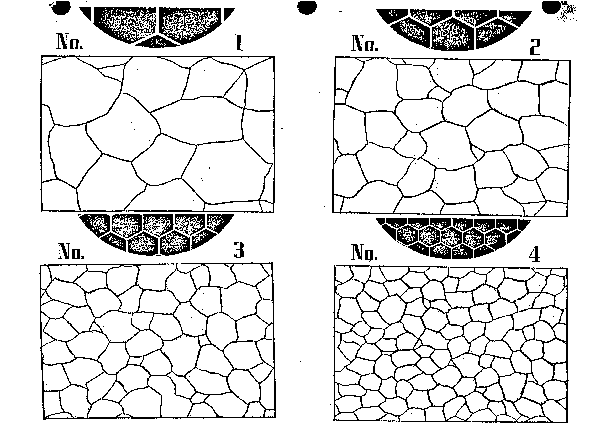Date: Mon Jan 31 09:55:42 2000
Posted By: Bob Novak, Other (pls. specify below), Sr Process Research Engineer, Carpenter Technology
Area of science: Engineering
ID: 947866744.Eg
Message:
Hi Adam,
Lets take your questions in reverse order.
 Metals have crystaline structures. A grain is a single crystal in a
metallic material. The grains form when the metal solidifies from a liquid.
Metals have a tendancy to fracture or break along the grain boundaries.
Metals with large elongated grains are usually not as strong as metals
with smaller and more spherical grains.
ASTM method E 112 provides a detailed explanation of how grains are
measured. The following images are examples of different size grains with
ASTM size ratings. The sample is polished and viewed through a microscope
at 100 X magnification. Typically, an etch (chemical solution) is used to
enhance the contrast between the grains and the grain boundaries. One
method for measuring grain size is to draw a line of known length across a
portion of the image and count the number of times a grain boundary
crosses the line. The average grain diameter is the line length divided by
the number of grain boundaries.
ASTM method E 112 has a table for converting average grain diameter to
grain size.
Metals have crystaline structures. A grain is a single crystal in a
metallic material. The grains form when the metal solidifies from a liquid.
Metals have a tendancy to fracture or break along the grain boundaries.
Metals with large elongated grains are usually not as strong as metals
with smaller and more spherical grains.
ASTM method E 112 provides a detailed explanation of how grains are
measured. The following images are examples of different size grains with
ASTM size ratings. The sample is polished and viewed through a microscope
at 100 X magnification. Typically, an etch (chemical solution) is used to
enhance the contrast between the grains and the grain boundaries. One
method for measuring grain size is to draw a line of known length across a
portion of the image and count the number of times a grain boundary
crosses the line. The average grain diameter is the line length divided by
the number of grain boundaries.
ASTM method E 112 has a table for converting average grain diameter to
grain size.
 Notice that the larger grains have a smaller ASTM grain size.
If you require a more detailed explanation, I recommend an introductory
course to metallurgy.
Bob Novak
Specialist -Process R&D
Carpenter Technology
Notice that the larger grains have a smaller ASTM grain size.
If you require a more detailed explanation, I recommend an introductory
course to metallurgy.
Bob Novak
Specialist -Process R&D
Carpenter Technology
Current Queue |
Current Queue for Engineering |
Engineering archives
Try the links in the MadSci Library for more information on Engineering.
MadSci Home | Information |
Search |
Random Knowledge Generator |
MadSci Archives |
Mad Library | MAD Labs |
MAD FAQs |
Ask a ? |
Join Us! |
Help Support MadSci
MadSci Network,
webadmin@www.madsci.org
© 1995-2000. All rights reserved.
 Metals have crystaline structures. A grain is a single crystal in a
metallic material. The grains form when the metal solidifies from a liquid.
Metals have a tendancy to fracture or break along the grain boundaries.
Metals with large elongated grains are usually not as strong as metals
with smaller and more spherical grains.
ASTM method E 112 provides a detailed explanation of how grains are
measured. The following images are examples of different size grains with
ASTM size ratings. The sample is polished and viewed through a microscope
at 100 X magnification. Typically, an etch (chemical solution) is used to
enhance the contrast between the grains and the grain boundaries. One
method for measuring grain size is to draw a line of known length across a
portion of the image and count the number of times a grain boundary
crosses the line. The average grain diameter is the line length divided by
the number of grain boundaries.
ASTM method E 112 has a table for converting average grain diameter to
grain size.
Metals have crystaline structures. A grain is a single crystal in a
metallic material. The grains form when the metal solidifies from a liquid.
Metals have a tendancy to fracture or break along the grain boundaries.
Metals with large elongated grains are usually not as strong as metals
with smaller and more spherical grains.
ASTM method E 112 provides a detailed explanation of how grains are
measured. The following images are examples of different size grains with
ASTM size ratings. The sample is polished and viewed through a microscope
at 100 X magnification. Typically, an etch (chemical solution) is used to
enhance the contrast between the grains and the grain boundaries. One
method for measuring grain size is to draw a line of known length across a
portion of the image and count the number of times a grain boundary
crosses the line. The average grain diameter is the line length divided by
the number of grain boundaries.
ASTM method E 112 has a table for converting average grain diameter to
grain size.
 Notice that the larger grains have a smaller ASTM grain size.
If you require a more detailed explanation, I recommend an introductory
course to metallurgy.
Bob Novak
Specialist -Process R&D
Carpenter Technology
Notice that the larger grains have a smaller ASTM grain size.
If you require a more detailed explanation, I recommend an introductory
course to metallurgy.
Bob Novak
Specialist -Process R&D
Carpenter Technology